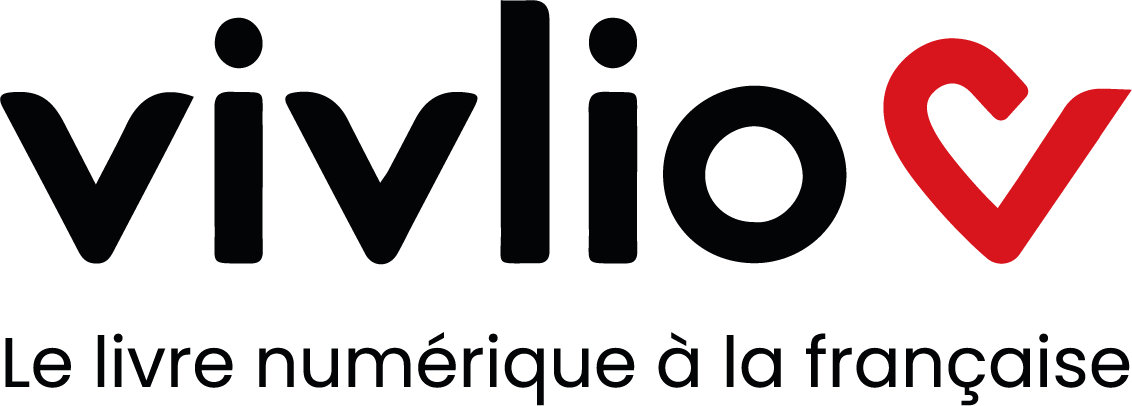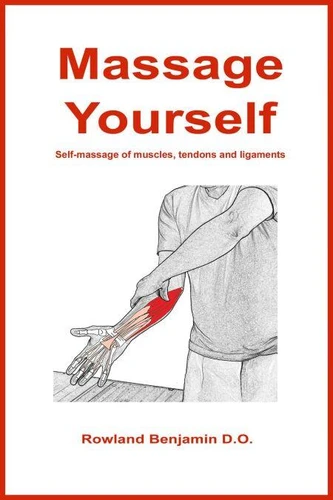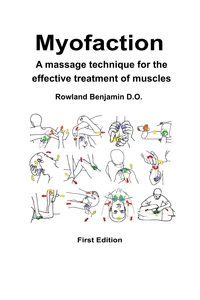Massage Yourself
Par :Formats :
Disponible dans votre compte client Decitre ou Furet du Nord dès validation de votre commande. Le format ePub est :
- Compatible avec une lecture sur My Vivlio (smartphone, tablette, ordinateur)
- Compatible avec une lecture sur liseuses Vivlio
- Pour les liseuses autres que Vivlio, vous devez utiliser le logiciel Adobe Digital Edition. Non compatible avec la lecture sur les liseuses Kindle, Remarkable et Sony
 , qui est-ce ?
, qui est-ce ?Notre partenaire de plateforme de lecture numérique où vous retrouverez l'ensemble de vos ebooks gratuitement
Pour en savoir plus sur nos ebooks, consultez notre aide en ligne ici
- FormatePub
- ISBN978-0-9581119-3-5
- EAN9780958111935
- Date de parution15/12/2022
- Protection num.pas de protection
- Infos supplémentairesepub
- ÉditeurRowland Benjamin
Résumé
Massage Yourself is concerned with self-treatment, self-help and personal empowerment and describes a remedial massage system where you massage yourself. The book focuses on specific muscles without unnecessary repetition. It covers two main types of technique: kneading and friction, and explains which muscles, tendons and ligaments are being massaged, where they are located, which part of your hand or massage tool is best to use and it explains how to do the massage technique.
It is clear, easy to read, user friendly and contains hundreds of photographs and line drawings showing massage techniques for every part of the body, as well as anatomy illustrations and provides bullet points, which take you through the techniques step-by-step. Self-massage can complement treatment by helping to fix problems or remove the need for treatment by preventing health problems developing.
The book is useful for anyone who works with their own body, including manual workers, musicians, dancers, yoga students, personal trainers, sports coaches, athletes and sports people, or anyone who works on other people's bodies including masseurs, osteopaths, physiotherapists, chiropractors, manual therapists, yoga teachers, naturopaths, medical doctors, exercise physiologists, Pilates and aerobics teachers. Self-massage can reduce treatment time and improve the health and efficiency of your muscles, tendons and ligaments without the need for expensive equipment, and once learned, can be used safely at home.
It is especially useful when lots of short sessions of treatment are needed but are inconvenient for the patient. A patient can be working on his or her problem between treatments. Working from home can be so much easier and time saving. Massage Yourself is divided into introduction, techniques and appendix. The introduction defines some of the key terms, goals and concepts around self-massage, explains how massage works and how it can be used.
It discusses the difference between massage and self-massage and the pros and cons of self-massage. It looks at the dozen or so places on the hand from where contact and pressure is applied to the soft tissues and the three massage tools recommended in this book: the two rubber balls in a net, the tightly rolled-up towel and the wadi, and indications and contraindication for their use. It explains the purpose of the techniques and the differences between them. The introduction also looks at other types of massage, as well as anatomy, ergonomics, the working environment, palpation (the art and skill of feeling soft tissues), props, the ideal routine, side effects and as well it provides tips on how to do self-massage, especially for first time users.
It lists medical conditions requiring caution and looks at how gravity, lifestyle, genetics and the curvatures of the spine affect posture. The technique section is divided into part A jaw and spine, part B upper limb and part C lower limb and contains the massage techniques, including the starting positions (standing, sitting on a chair, laying on your back or kneeling on the floor) and the actions needed for the execution of the technique.
This main section works through the soft tissues of the body in the following order: jaw, suboccipital, cervical and thoracic spine, ribs, lumbar and sacroiliac spine, shoulder, arm, elbow, forearm, wrist, hand, hip, thigh, knee, leg, ankle and foot. The appendix contains a glossary of anatomical terms used in this book and a list of muscles and their actions. I have used words that everyone can understand, but in a technical book like this some words will inevitably fall outside the domain of common usage.
When these words needed to be explained they were added to the list in the appendix.
It is clear, easy to read, user friendly and contains hundreds of photographs and line drawings showing massage techniques for every part of the body, as well as anatomy illustrations and provides bullet points, which take you through the techniques step-by-step. Self-massage can complement treatment by helping to fix problems or remove the need for treatment by preventing health problems developing.
The book is useful for anyone who works with their own body, including manual workers, musicians, dancers, yoga students, personal trainers, sports coaches, athletes and sports people, or anyone who works on other people's bodies including masseurs, osteopaths, physiotherapists, chiropractors, manual therapists, yoga teachers, naturopaths, medical doctors, exercise physiologists, Pilates and aerobics teachers. Self-massage can reduce treatment time and improve the health and efficiency of your muscles, tendons and ligaments without the need for expensive equipment, and once learned, can be used safely at home.
It is especially useful when lots of short sessions of treatment are needed but are inconvenient for the patient. A patient can be working on his or her problem between treatments. Working from home can be so much easier and time saving. Massage Yourself is divided into introduction, techniques and appendix. The introduction defines some of the key terms, goals and concepts around self-massage, explains how massage works and how it can be used.
It discusses the difference between massage and self-massage and the pros and cons of self-massage. It looks at the dozen or so places on the hand from where contact and pressure is applied to the soft tissues and the three massage tools recommended in this book: the two rubber balls in a net, the tightly rolled-up towel and the wadi, and indications and contraindication for their use. It explains the purpose of the techniques and the differences between them. The introduction also looks at other types of massage, as well as anatomy, ergonomics, the working environment, palpation (the art and skill of feeling soft tissues), props, the ideal routine, side effects and as well it provides tips on how to do self-massage, especially for first time users.
It lists medical conditions requiring caution and looks at how gravity, lifestyle, genetics and the curvatures of the spine affect posture. The technique section is divided into part A jaw and spine, part B upper limb and part C lower limb and contains the massage techniques, including the starting positions (standing, sitting on a chair, laying on your back or kneeling on the floor) and the actions needed for the execution of the technique.
This main section works through the soft tissues of the body in the following order: jaw, suboccipital, cervical and thoracic spine, ribs, lumbar and sacroiliac spine, shoulder, arm, elbow, forearm, wrist, hand, hip, thigh, knee, leg, ankle and foot. The appendix contains a glossary of anatomical terms used in this book and a list of muscles and their actions. I have used words that everyone can understand, but in a technical book like this some words will inevitably fall outside the domain of common usage.
When these words needed to be explained they were added to the list in the appendix.
Massage Yourself is concerned with self-treatment, self-help and personal empowerment and describes a remedial massage system where you massage yourself. The book focuses on specific muscles without unnecessary repetition. It covers two main types of technique: kneading and friction, and explains which muscles, tendons and ligaments are being massaged, where they are located, which part of your hand or massage tool is best to use and it explains how to do the massage technique.
It is clear, easy to read, user friendly and contains hundreds of photographs and line drawings showing massage techniques for every part of the body, as well as anatomy illustrations and provides bullet points, which take you through the techniques step-by-step. Self-massage can complement treatment by helping to fix problems or remove the need for treatment by preventing health problems developing.
The book is useful for anyone who works with their own body, including manual workers, musicians, dancers, yoga students, personal trainers, sports coaches, athletes and sports people, or anyone who works on other people's bodies including masseurs, osteopaths, physiotherapists, chiropractors, manual therapists, yoga teachers, naturopaths, medical doctors, exercise physiologists, Pilates and aerobics teachers. Self-massage can reduce treatment time and improve the health and efficiency of your muscles, tendons and ligaments without the need for expensive equipment, and once learned, can be used safely at home.
It is especially useful when lots of short sessions of treatment are needed but are inconvenient for the patient. A patient can be working on his or her problem between treatments. Working from home can be so much easier and time saving. Massage Yourself is divided into introduction, techniques and appendix. The introduction defines some of the key terms, goals and concepts around self-massage, explains how massage works and how it can be used.
It discusses the difference between massage and self-massage and the pros and cons of self-massage. It looks at the dozen or so places on the hand from where contact and pressure is applied to the soft tissues and the three massage tools recommended in this book: the two rubber balls in a net, the tightly rolled-up towel and the wadi, and indications and contraindication for their use. It explains the purpose of the techniques and the differences between them. The introduction also looks at other types of massage, as well as anatomy, ergonomics, the working environment, palpation (the art and skill of feeling soft tissues), props, the ideal routine, side effects and as well it provides tips on how to do self-massage, especially for first time users.
It lists medical conditions requiring caution and looks at how gravity, lifestyle, genetics and the curvatures of the spine affect posture. The technique section is divided into part A jaw and spine, part B upper limb and part C lower limb and contains the massage techniques, including the starting positions (standing, sitting on a chair, laying on your back or kneeling on the floor) and the actions needed for the execution of the technique.
This main section works through the soft tissues of the body in the following order: jaw, suboccipital, cervical and thoracic spine, ribs, lumbar and sacroiliac spine, shoulder, arm, elbow, forearm, wrist, hand, hip, thigh, knee, leg, ankle and foot. The appendix contains a glossary of anatomical terms used in this book and a list of muscles and their actions. I have used words that everyone can understand, but in a technical book like this some words will inevitably fall outside the domain of common usage.
When these words needed to be explained they were added to the list in the appendix.
It is clear, easy to read, user friendly and contains hundreds of photographs and line drawings showing massage techniques for every part of the body, as well as anatomy illustrations and provides bullet points, which take you through the techniques step-by-step. Self-massage can complement treatment by helping to fix problems or remove the need for treatment by preventing health problems developing.
The book is useful for anyone who works with their own body, including manual workers, musicians, dancers, yoga students, personal trainers, sports coaches, athletes and sports people, or anyone who works on other people's bodies including masseurs, osteopaths, physiotherapists, chiropractors, manual therapists, yoga teachers, naturopaths, medical doctors, exercise physiologists, Pilates and aerobics teachers. Self-massage can reduce treatment time and improve the health and efficiency of your muscles, tendons and ligaments without the need for expensive equipment, and once learned, can be used safely at home.
It is especially useful when lots of short sessions of treatment are needed but are inconvenient for the patient. A patient can be working on his or her problem between treatments. Working from home can be so much easier and time saving. Massage Yourself is divided into introduction, techniques and appendix. The introduction defines some of the key terms, goals and concepts around self-massage, explains how massage works and how it can be used.
It discusses the difference between massage and self-massage and the pros and cons of self-massage. It looks at the dozen or so places on the hand from where contact and pressure is applied to the soft tissues and the three massage tools recommended in this book: the two rubber balls in a net, the tightly rolled-up towel and the wadi, and indications and contraindication for their use. It explains the purpose of the techniques and the differences between them. The introduction also looks at other types of massage, as well as anatomy, ergonomics, the working environment, palpation (the art and skill of feeling soft tissues), props, the ideal routine, side effects and as well it provides tips on how to do self-massage, especially for first time users.
It lists medical conditions requiring caution and looks at how gravity, lifestyle, genetics and the curvatures of the spine affect posture. The technique section is divided into part A jaw and spine, part B upper limb and part C lower limb and contains the massage techniques, including the starting positions (standing, sitting on a chair, laying on your back or kneeling on the floor) and the actions needed for the execution of the technique.
This main section works through the soft tissues of the body in the following order: jaw, suboccipital, cervical and thoracic spine, ribs, lumbar and sacroiliac spine, shoulder, arm, elbow, forearm, wrist, hand, hip, thigh, knee, leg, ankle and foot. The appendix contains a glossary of anatomical terms used in this book and a list of muscles and their actions. I have used words that everyone can understand, but in a technical book like this some words will inevitably fall outside the domain of common usage.
When these words needed to be explained they were added to the list in the appendix.




